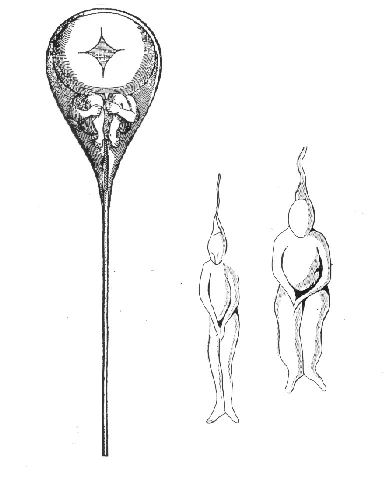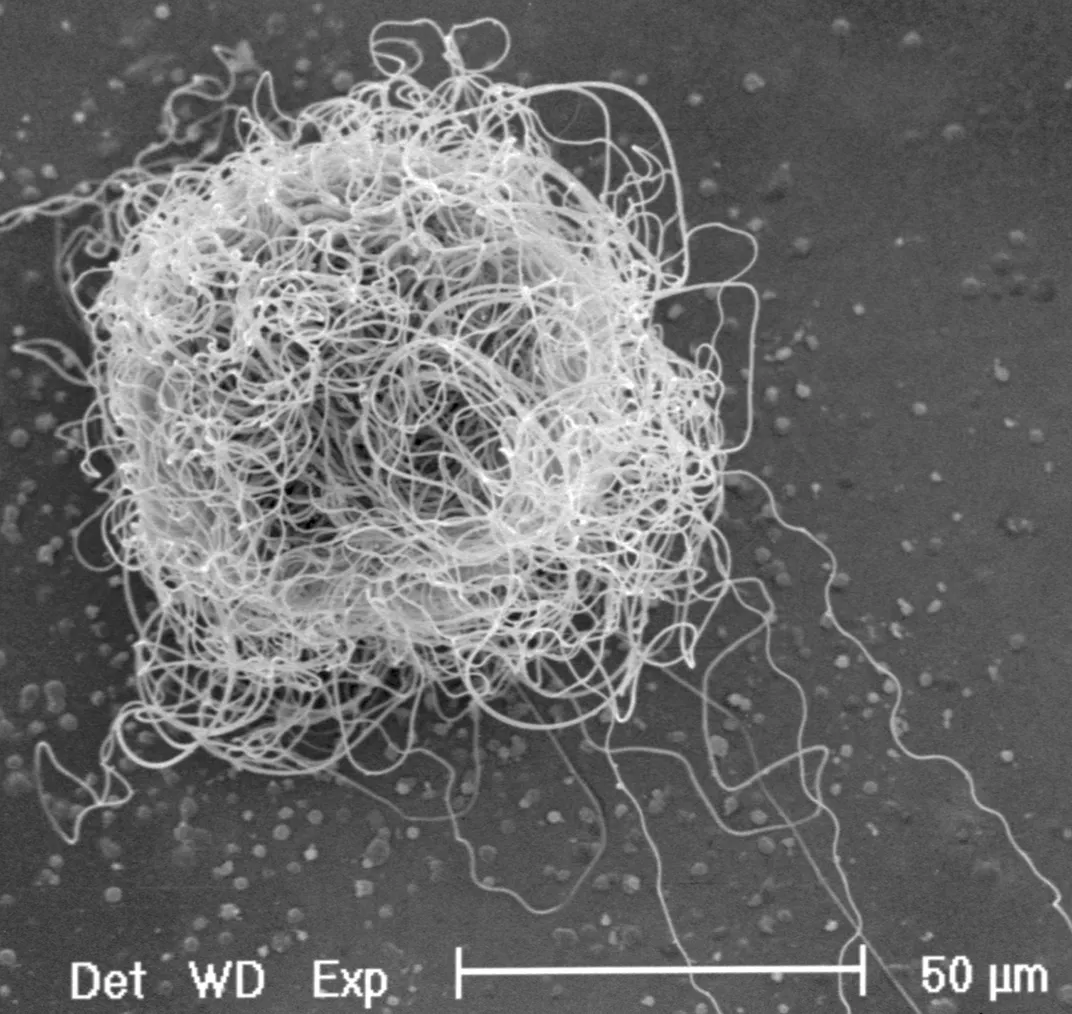The Long, Winding Tale of Sperm Science
…and why it’s finally headed in the right direction
Scott Pitnick’s tattoo isn't exactly subtle. The massive black-and-white sperm twists and spires up his right forearm, appearing to burrow in and out of his skin before emerging into a fist-sized head on his bicep. Nor is the Syracuse University biologist reserved about his unusual body art, which once made an appearance in a montage of notable scientist tattoos published in The Guardian.
For Pitnick, his intricate ink reflects his deep fascination in sperm’s “unbelievably unique biology.” Consider, he says, that sperm are the only cells in the body destined to be cast forth into a foreign environment—a feat that requires dramatic physical changes as they travel from the testes into a woman’s reproductive tract.
“No other cells do that,” says Pitnick, who has been studying sperm for more than 20 years. “They have this autonomy.”
In his lab, Pitnick engineers the heads of fruit fly sperm to glow a ghostly red and green so that he can observe them moving through dissected female fly reproductive tracts. He hopes his work will help reveal how sperm behave within female bodies, an area of research that's still in its relative infancy. These kinds of innovations could one day explain the great diversity of sperm shape and size across the animal kingdom. Moreover, they could ultimately help researchers develop human infertility treatments, as well as more effective male contraceptives.
“We understand almost nothing about sperm function, what sperm do,” Pitnick says. Many of the answers to these unknowns likely hide within the other half of sperm’s puzzle: female bodies.
This might come as a disappointment to the courageous biologists who first looked upon sperm cells in their full glory in the 17th and 18th century, using the then-revolutionary microscope. These early sperm scientists found themselves tasked with answering the most basic of questions, for instance: Are sperm living animals? Are they parasites? And, Does each sperm contain a tiny pre-formed adult human curled up inside? (We’ll get to that one later.)
/https://tf-cmsv2-smithsonianmag-media.s3.amazonaws.com/filer/7d/b8/7db8111d-000d-4ef4-b057-6c60dceeeafb/sperm_image_1-wr.jpg)
The person with the dubious honor of being the first to study sperm in detail was Anton van Leeuwenhoek, a Dutchman who developed the early compound microscope. Van Leeuwenhoek first used his new tool to examine more chaste subjects such as bee stingers, human lice and lake water in the mid-1670s.
Colleagues urged him to turn his lens to semen. But he worried it would be indecent to write about semen and intercourse, and so he stalled. Finally, in 1677, he gave in. Examining his own ejaculate, he was immediately struck by the tiny “animalcules” he found wriggling inside.
Hesitant to even share his findings with colleagues—let alone get a wriggler tattooed on his arm—van Leeuwenhoek hesitantly wrote to the Royal Society of London about his discovery in 1677. “If your Lordship should consider that these observations may disgust or scandalise the learned, I earnestly beg your Lordship to regard them as private and to publish or destroy them as your Lordship sees fit.”
His Lordship (aka the president of the Royal Society) did opt to publish van Leeuwenhoek’s findings in the journal Philosophical Transactions in 1678—thus begetting the brand new field of sperm biology.
It’s hard to overstate how mysterious these squirming, microscopic commas would have appeared to scientists at the time. Before the discovery of these “animalcules,” theories of how humans made more humans ranged widely, says Bob Montgomerie, a biologist who studies animal reproduction at Queen’s University in Canada. For example, some believed that vapor emitted by male ejaculate somehow stimulated females to make babies, while others believed that men actually made babies and transferred them to females for incubation.
“You can imagine how difficult it is when you have no idea what is going on,” says Montgomerie. That is: without being able to see sperm and eggs, these scientists were really just pulling theories out of thin air.

Even after van Leeuwenhoek discovered sperm in 1677, roughly 200 years passed before scientists agreed on how humans formed. Two primary fields of thought emerged along the way: On the one hand, the “preformationists” believed that each spermatozoa—or each egg, depending on who you asked—contained a tiny, completely pre-formed human. Under this theory, the egg—or sperm—simply provided a place for development to occur.
On the other hand, “epigenesists” argued that both males and females contributed material to form a new organism, though they weren’t sure who contributed exactly what. Discoveries throughout the 1700s offered more evidence for this argument, including the 1759 discovery that chicks develop organs incrementally. (Montgomerie notes this in the book Sperm Biology: An Evolutionary Perspective, which was edited by colleagues including Pitnick.)
With improvements to the microscope, mid-19th century researchers observed embryonic development within sea urchin eggs, which are conveniently transparent. These observations continued to disprove the concept of preformation, and allowed researchers to begin asking how sperm and egg work together to create new organisms.
Sperm research also shed light on other body systems. In the 1960s, researchers identified the protein dynein, which is responsible for sperm movement. “It turns out that the same motor protein is responsible for all kinds of processes that go on in cells,” says Charles Lindemann, a professor emeritus at Oakland University in Michigan who studied sperm motility. Today we know that dynein is involved in the movement of microscopic cellular structures like cilia and flagella, which are key to many bodily functions.
Still, early progress in fertility research was slow to take off. There simply weren’t very many working scientists back then at all, let alone sperm scientists, says Montgomerie. He estimates that there were only several dozen people researching sperm at that time; by comparison, roughly 400,000 scientists study cancer today. “There were some people doing it, but maybe not enough,” says Montgomerie.
Pitnick adds that the few early researchers who did study sperm may not have fully appreciated the role of the female reproductive system in the fertility equation—an oversight that could explain why this area is still such a mystery today. “Part of that is a male bias in biology to think the female is not an important part of the story, and that goes way back in sperm biology to this whole idea of preformation,” says Pitnick.
On the more technical side, observing sperm move within the female is logistically very challenging. As Pitnick points out, it’s pretty hard to get a camera inside a female reproductive tract.
That's the genius behind his glowing fruit fly sperm and the ability to monitor them in real time. The video above shows the removed reproductive tract of a female fruit fly, which Pitnick has kept intact in a saline solution. When it was living, that female was mated to a green-sperm male, and then re-mated a few days later with a red-sperm male. Only the heads of the sperm are tagged with the fluorescent protein, so the tails of the sperm cannot be seen.
With this kind of technology, Pitnick can gain insight into why so much variety exists in the shape and size of sperm. For example, the glowing sperm he studies have mega-long tails reaching up to 6 centimeters in length when unwound—roughly the length of your pinky finger, and the longest known in the animal kingdom. He has spent decades trying to understand why a fly would evolve this way, and has finally honed in on the female reproductive tract as the source for his answer.
While Pitnick focuses on flies, sperm have also captured the attention of modern scientists trying to help human couples trying to conceive. Pitnick’s findings could inadvertently help with this task. “In many cases, it is a compatibility difference between a specific male and female, and they don’t know the underlying mechanism,” he says. “Understanding sperm-female interactions can certainly shed light on understanding new explanations for infertility, and possibly new solutions for it.”
Basic sperm research will also help expedite progress in developing male contraceptives, says Daniel Johnston, chief of the Contraception Research Branch at the National Institutes of Health. So far, researchers have tried everything from gels to pills, but an effective, reliable male birth control remains elusive. Johnston says scientists still face the most basic of questions: what is sperm, anyways?

“We need to really understand what makes up a sperm,” says Johnston, who has worked to describe the full protein contents of sperm—an important first step in understanding how to design effective contraceptives. “When you understand that, you can potentially start understanding what we need to inhibit.”
Recently, a private group called the Male Contraceptive Initiative launched a competition that will fund one innovative contraceptive research project.* Gunda Georg, a medicinal chemist at the University of Minnesota, has made it through the first round of the contest for her research on infertility-associated genes in mice that could ultimately be used to develop a male birth control pill.
Her current research helps determine appropriate dosage levels for such pharmaceuticals and assess potential side effects. After all, “if a man stops taking the pill, he has to completely return to normal,” Georg says.
Johnston is pleased to have the opportunity to support this type of research at the NIH, both out of interest in moving male contraceptives forward but also out of a fundamental intrigue in sperm that hasn’t let up over his 25-year career. “Sperm are fascinating," says Johnston. "There is nothing like them.”
Pitnick, naturally, agrees. The bashfulness that scientists like van Leeuwenhoek demonstrated in the early days, he says, has subsided in the field. “I don’t think there are too many biologists today that have any kind of discomfort level talking about this stuff,” says Pitnick. And for him, personally? “I love this biology,” he says. “I’ll talk to anyone about it who is willing to listen.”
Editor's Note, June 7, 2017: This piece originally stated that the Male Contraceptive Initiative was housed under the NIH; it is a private endeavor.